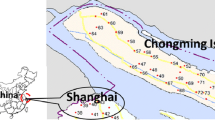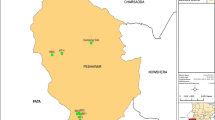Abstract
Purpose
Combinatorial bio/chemical approach was applied to investigate dioxin-like contamination of soil and sediment at the petrochemical and organochlorine plant in Pancevo, Serbia, after the destruction of manufacturing facilities that occurred in the spring of 1999 and subsequent remediation actions.
Materials and methods
Soil samples were analyzed for indicator polychlorinated biphenyls (PCBs) by gas chromatography/electron capture detection (GC/ECD). Prioritized soil sample and sediment samples from the waste water channel were analyzed for polychlorinated dibenzo-p-dioxins and dibenzofurans (PCDD/Fs) by high-resolution gas chromatography/high-resolution mass spectrometry (HRGC/HRMS). Microethoxyresorufin o-deethylase (Micro-EROD) and H4IIE–luciferase bioassays were used for monitoring of dioxin-like compounds (DLC) and for better characterization of dioxin-like activity of soil samples.
Results
Bioanalytical results indicated high dioxin-like activity in one localized soil sample, while the chemical analysis confirmed the presence of large quantities of DLC: 3.0 × 105 ng/g d.w. of seven-key PCBs, 8.2 ng/g d.w. of PCDD/Fs, and 3.0 × 105 ng/g d.w. of planar and mono-ortho PCBs. In the sediment, contaminant concentrations were in the range 2–8 ng/g d.w. of PCDD/Fs and 9–20 ng/g d.w. of PCBs.
Conclusions
This study demonstrates the utility of combined application of bioassays and instrumental analysis, especially for developing and transition country which do not have capacity of the expensive instrumental analysis. The results indicate the high contamination of soil in the area of petrochemical plant, and PCDD/Fs contamination of the sediment from the waste water channel originating from the ethylene dichloride production.
Similar content being viewed by others
References
Aarts JMMJG, Denison MS, Cox MA, Schalk MA, Garrison PM, Tullis K, de Haan LH, Brouwer A (1995) Species-specific antagonism of Ah receptor action by 2, 2′, 5, 5′-tetrachloro- and 2, 2′, 3, 3′, 4, 4′-hexachlorobiphenyl. Eur J Pharmacol Environ Toxicol Pharmacol Sect 293:463–474
Andersson E, Rotander A, von Kronhelm T, Berggren A, Ivarsson P, Hollert H, Engwall M (2009) AhR agonist and genotoxicant bioavailability in a PAH-contaminated soil undergoing biological treatment. Environ Sci Pollut Res 16:521–530
Behnisch PA, Hosoe K, Brouwer A, Sakai S-I (2002) Screening of dioxin-like toxicity equivalents for various matrices with wildtype and recombinant rat hepatoma H4IIE cells. Toxicol Sci 69:125–130
Behnisch PA, Hosoe K, Sakai S-I (2003) Brominated dioxin-like compounds: in vitro assessment in comparison to classical dioxin-like compounds and other polyaromatic compounds. Environ Int 29:861–877
Bittner M, Janošek J, Hilscherova K, Giesy J, Holoubek I, Blaha L (2006) Activation of Ah receptor by pure humic acids. Environ Toxicol 21:338–342
Brack W (2003) Effect-directed analysis: a promising tool for the identification of organic toxicants in complex mixtures? Anal Bioanal Chem 377:397–407
Brack W, Segner H, Möder M, Schüürmann G (2000) Fixed-effect-level toxicity equivalents—a suitable parameter for assessing ethoxyresorufin-O-deethylase induction potency in complex environmental samples. Environ Toxicol Chem 19:2493–2501
Brown VJ (2004) Battle scars—global conflicts and environmental health. Environ Health Perspect 112:A994–A1003
Carroll WF Jr, Berger TC, Borrelli FE, Garrity PJ, Jacobs RA, Ledvina J, Lewis JW, McCreedy RL, Smith TP, Tuhovak DR, Weston AF (2001) Characterization of emissions of dioxins and furans from ethylene dichloride, vinyl chloride monomer and polyvinyl chloride facilities in the United States. Consolidated report. Chemosphere 43:689–700
Fattore E, Benfenati E, Mariani G, Fanelli R (1997) Patterns and sources of polychlorinated dibenzo-p-dioxins and dibenzofurans in sediments from the Venice Lagoon, Italy. Environ Sci Technol 31:1777–1784
Heinisch E, Kettrup A, Bergheim W, Wenzel S (2007) Persistent chlorinated hydrocarbons, source-oriented monitoring in aquatic media. 6. Strikingly high contaminated sites. Fresenius Environ Bull 16(10):1248–1273
Hilscherova K, Kannan K, Kang Y-S, Holoubek I, Machala M, Masunaga S, Nakanishi J, Giesy JP (2001) Characterization of dioxin-like activity of sediments from a Czech river basin. Environ Toxicol Chem 20:2768–2777
Im SH, Kannan K, Giesy JP, Matsuda M, Wakimoto T (2002) Concentrations and profiles of polychlorinated dibenzo-p-dioxins and dibenzofurans in soils from Korea. Environ Sci Technol 36:3700–3705
Isosaari P, Kohonen T, Kiviranta H, Tuomisto J, Vartiainen T (2000) Assesment of levels, distribution, and risks of polychlorinated dibenzo-p-dioxins and dibenzofurans in the vicinity of a vinyl chloride monomer production plant. Environ Sci Technol 34:2684–2689
Kaisarevic S, Andric N, Bobic S, Trickovic J, Teodorovic I, Vojinovic-Miloradov M, Kovacevic R (2007) Detection of dioxin-like contaminants in soil from the area of oil refineries in Vojvodina region of Serbia. Bull Environ Contam Toxicol 79:422–426
Kaisarevic S, Lubcke-von Varel U, Orcic D, Streck G, Schulze T, Pogrmic K, Teodorovic I, Brack W, Kovacevic R (2009) Effect-directed analysis of contaminated sediment from the wastewater canal in Pancevo industrial area, Serbia. Chemosphere 77:907–913
Krizanec B, Majcen Le Marechal A, Voncina E, Brodnjak-Voncina D (2005) Presence of dioxins in textile dyes and their fate during the dyeing processes. Acta Chim Slov 52:111–118
Nadal M, Schuhmacher M, Domingo JL (2007) Levels of metals, PCBs, PCNs and PAHs in soils of a highly industrialized chemical/petrochemical area: temporal trend. Chemosphere 66:267–276
Norwegian SFT (2005) Veileder for risikovurdering av forurenset sediment (TA-2085/2005). Rev 1, juni 2005
Picer M, Kovacevic R, Picer N, Kobasic VH, Calic V, Zoric S (2006) Characterization of soil and sediment samples collected from the Zadar area, Croatia, by GC-ECD PCB analysis and bioassay. Bull Environ Contam Toxicol 77:687–693
Radonic J, Turk Sekulic M, Vojinovic Miloradov M, Cupr P, Klanova J (2009) Gas-particle partitioning of persistent organic pollutants in the Western Balkan countries affected by war conflicts. Environ Sci Pollut Res 16:65–72
Rastall A, Getting D, Goddard J, Roberts DR, Erdinger L (2006) A biomimetic approach to the detection and identification of estrogen receptor agonists in surface waters using semipermeable membrane devices (SPMDs) and bioassay-directed chemical analysis. Environ Sci Pollut Res 13(4):256–267
Sanderson JT, Aarts JMMJG, Brouwer A, Froese KL, Denison MS, Giesy JP (1996) Comparison of Ah Receptor-mediated luciferase and ethoxyresorufin-O-deethylase induction in H4IIE cells: implications for their use as bioanalytical tools for the detection of polyhalogenated aromatic hydrocarbons. Toxicol Appl Pharmacol 137:316–325
Song M, Jiang Q, Xu Y, Liu H, Lam PKS, O’Toole DK, Zhang Q, Giesy JP, Jiang G (2006) AhR-active compounds in sediments of the Haihe and Dagu Rivers, China. Chemosphere 66:1222–1230
Stockholm Convention (2001) http://www.pops.int
Sundqvist KL, Tysklind M, Cato I, Bignert A, Wiberg K (2009) Levels and homologue profiles of PCDD/Fs in sediments along the Swedish coast of the Baltic Sea. Environ Sci Pollut Res 16(4):396–409
Teodorovic I (2009) Ecotoxicological research and related legislation in Serbia. Environ Sci Pollut Res 16:S123–S129
Torres JPM, Leite C, Krauss T, Weber R (2008) A contaminated site from the chlorine/organochlorine industry as source of PCDD/F contamination of citrus pulp pellets used as animal feed in Europe during the late 1990’s. Organohalogen Compounds 70:793–796
UNEP (1999a) UNEP Final Report: The Kosovo conflict: consequences for the environment & human settlements, http://postconflict.unep.ch/publications.php?prog=kosovo
UNEP (1999b) UNEP/UNCHS Balkans Task Force. BTF—Technical Industrial Sites Mission Report: Analytical Laboratory Results from the German Federal Environmental Agency and Brandenburg State Office for Environment. <http://www.grid.unep.ch/btf/missions/sites/obrenovac.pdf>.
UNEP (2004) From conflict to sustainable development. Assessment and clean-up in Serbia and Montenegro, http://postconflict.unep.ch/publications/sam.pdf
van den Berg M, Birnbaum LS, Denison M, De Vito M, Farland W, Feeley M, Fiedler H, Hakansson H, Hanberg A, Haws L, Rose M, Safe S, Schrenk D, Tohyama C, Tritscher A, Toumisto J, Tysklind M, Walker N, Peterson RE (2006) The 2005 World Health Organization re-evaluation of human and mammalian toxic equivalency factors for dioxins and dioxin-like compounds. Toxicol Sci 93:223–241
Verta M, Kiviranta H, Salo S, Malve O, Korhonen M, Verkasalo PK, Ruokojärvi P, Rossi E, Hanski A, Päätalo K, Vartiainen T (2009) A decision framework for possible remediation of contaminated sediments in the River Kymijoki, Finland. Environ Sci Pollut Res 16:95–105
Weber R, Gaus C, Tysklind M, Johnston P, Forter M, Hollert H, Heinisch E, Holoubek I, Lloyd-Smith M, Masunaga S, Moccarelli P, Santillo D, Seike N, Symons R, Torres JPM, Verta M, Varbelow G, Vijgen J, Watson A, Costner P, Woelz J, Wycisk P, Zennegg M (2008) Dioxin- and POP-contaminated sites—contemporary and future relevance and challenges. Environ Sci Pollut Res 15:363–393
Wölz J, Engwall M, Maletz S, Olsmann H, van Bavel B, Kammann U, Klempt M, Weber R, Braunbeck T, Hollert H (2008) Changes in toxicity and dioxin-like activity of suspended particulate matter during flood events at the rivers Neckar and Rhine. Environ Sci Pollut Res 15:536–553
Zeiger M, Haag R, Höckel J, Schrenk D, Schmitz H-J (2001) Inducing effects of dioxin-like polychlorinated biphenyls on CYP1A in the human hepatoblastoma cell line HepG2, the rat hepatoma cell line H4IIE, and rat primary hepatocytes: comparison of relative potencies. Toxicol Sci 63:65–73
Zoric S, Andric N, Sudji J, Klanova J, Jovetic S, Kovacevic R, Vojinovic-Miloradov M (2004) Ethoxyresorufin-O-deethylase induction potency in sediment samples from rivers Lepenica and Morava—surrounding area of Kragujevac “hot spot”. Organohalogen Compounds 66:598–602
Acknowledgments
This work was supported by Serbian Ministry of Science Grant No. 143058 and the Project INCHEMBIOL VZ0021622412. Rolf Anderson at the Department of Chemistry, Umeå University is acknowledged for performing comprehensive PCDD/F analysis and PCB analysis of sediments.
Author information
Authors and Affiliations
Corresponding author
Additional information
Responsible editor Ake Bergman
This article belongs to the series “Dioxin and POP contaminated sites” edited by Roland Weber, Mats Tysklind, and Caroline Gaus.
Rights and permissions
About this article
Cite this article
Kaisarevic, S., Hilscherova, K., Weber, R. et al. Characterization of dioxin-like contamination in soil and sediments from the “hot spot” area of petrochemical plant in Pancevo (Serbia). Environ Sci Pollut Res 18, 677–686 (2011). https://doi.org/10.1007/s11356-010-0418-8
Received:
Accepted:
Published:
Issue Date:
DOI: https://doi.org/10.1007/s11356-010-0418-8




